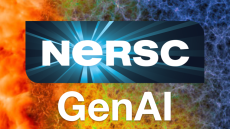NERSC Generative AI for Science Program
2024 GenAI Call for Proposals
In early 2024, NERSC invited proposals for projects that will leverage Perlmutter to push the state of the art in Generative AI (GenAI) and deep learning for science, as well as produce novel science outcomes. The call was focused on teams with expertise in the use of deep learning for science, a thorough understanding of the scientific domain, and demonstrated proofs of concept. With 55 proposals, 36 teams were awarded a total of O(300K) GPU node hours based on project scope, relevance to the NERSC mission areas, and readiness to use large computational resources at scale to advance their scientific outcome. Application areas include the use of novel GenAI models and techniques in material sciences, biological sciences, high-energy physics, weather (and climate) sciences, and applied mathematics.
The list of accepted teams (in no particular order) are:
| Project PI | PI Institution | Project Title |
| Tong Geng | University of Rochester | GenAI-based Prediction of Hot Electron and Neutron Generation for Nuclear Fusion |
| Vyacheslav Bryantsev | Oak Ridge National Laboratory | Reactive Chemistry in Molten Salts |
| Christopher Bretherton | Allen Institute for Artificial Intelligence | Efficient generative regional precipitation downscaling for a climate model emulator |
| Victor Batista | Yale University | High-Throughput Screening Drug Discovery Through Generative Model and Molecular Docking |
| Feng Yu | Lawrence Berkeley National Laboratory | AlphaSAXS - Reconstruct Protein Ensemble from High-throughput X-ray Scattering |
| Massimiliano Lupo Pasini | Oak Ridge National Laboratory | Generative graph-based AI for scalable, accurate, and transferable exploration of large chemical spaces for accelerated alloy design |
| Nesar Ramachandra | Argonne National Laboratory | Foundation Model Ecosystem for Computational Science |
| Zhong Wang | Lawrence Berkeley National Laboratory | A Biosynthetic Gene Cluster Foundation Model (bgcFM) for Systematically Exploring the Secondary Metabolic Capacity Encoded by Diverse Microbes |
| Sha Feng | Pacific Northwest National Laboratory | Building generative AI architectures to predict local wind energy generations using larger-scale environment |
| Gabriele Corso | MIT | Deciphering biomolecular structures with hierarchical latent diffusion models |
| Gebrand Ceder | Lawrence Berkeley National Laboratory | Inverse design of amorphous and crystalline materials for superionic conductors |
| Omar Yaghi | University of California Berkeley | Designing novel Metal-Organic Frameworks for Carbon Capture and Water Harvesting with Diffusion Model |
| Jackie Zhi Yao | Lawrence Berkeley National Laboratory | Multimodal Learning Framework Using Large Language Models for the Discovery of Inorganic Materials |
| Shaowu Pan | Rensselaer Polytechnic Institute | Scalable Scientific Machine Learning for Complex Physical Systems |
| Deyu Lu | Brookhaven National Laboratory | Atomic scale simulation of aqueous zinc electrolytes using deep neural network potentials and generative diffusion models |
| Bonnie Berger | MIT | An Ensemble for Every Protein: Diversifying the Protein Data Bank with AlphaFold and Gen AI |
| Tomasz Kacprzak | ETH Zurich | DES+DESC Generative AI for cosmology |
| Yihui Ren | Brookhaven National Laboratory | Feasibility study on AI Foundation Models for Particle Physics and Accelerators |
| Da Yang | University of Chicago | Constructing a hierarchy of ML models to understand the physics of the Madden-Julian Oscillation |
| Tommi Jaakkola | MIT | Structural Token Language Modeling of Proteins for Controllable Design |
| Rafael Gomez Bombarelli | MIT | Generative AI for Rigorous Thermodynamics of Material |
| Shinjae Yoo | Brookhaven National Laboratory | Foundation Neuroscience AI Model (NeuroX) |
| Pei Zhang | Oak Ridge National Laboratory | Multiscale foundation models for computational fluid dynamics |
| Tim Smith | NOAA Physical Sciences Laboratory | Ensemble Weather Generators for Data Assimilation and Forecasting at NOAA |
| Pablo Unzueta | Stanford University | Accelerating quantum chemistry and ab initio molecular dynamics with generative AI and deep learning |
| Aditi Krishnapriyan | University of California Berkeley | Generative Modeling for Molecular Dynamics using Graph Latent Differential Equations |
| Christopher Sutton | University of South Carolina | Advancing Heterogeneous Catalyst Design through Generative AI |
| Sokrates Pantelides | Vanderbit University | Unraveling vibrational properties of nanoconfined water through density functional theory and deep learning approaches |
| Mingda Li | MIT | Advanced Diffusion Model Strategy for Identifying Quantum Spin Liquid Candidates |
| Bin Yu | University of California Berkeley | Low Rank Fine-Tuning for One-Step to Many-Step Skill Transfer: Applying LoRA+ to Improve Medium-Range and Long-Range Weather and Climate Skill |
| Radi Radev | CERN | Scalable Sparse Diffusion Models for Neutrino Physics |
| Kristopher Bouchard | Lawrence Berkeley National Laboratory | Foundation Generative Pretrained Model for Proteins |
| Rajni Chahal | Oak Ridge National Laboratory | Uncertainty-guided Machine Learning Interatomic Potentials for Reactive Polymers |
| Rose Yu | University of California San Diego | Efficient diffusion-based modeling for weather and climate prediction |
| Shengchao Li | University of California Berkeley | Foundation Model on Materials |
| Weiqiang Zhu | University of California Berkeley | Foundation Model for Seismic Data |
About NERSC and Berkeley Lab
The National Energy Research Scientific Computing Center (NERSC) is a U.S. Department of Energy Office of Science User Facility that serves as the primary high performance computing center for scientific research sponsored by the Office of Science. Located at Lawrence Berkeley National Laboratory, NERSC serves almost 10,000 scientists at national laboratories and universities researching a wide range of problems in climate, fusion energy, materials science, physics, chemistry, computational biology, and other disciplines. Berkeley Lab is a DOE national laboratory located in Berkeley, California. It conducts unclassified scientific research and is managed by the University of California for the U.S. Department of Energy. »Learn more about computing sciences at Berkeley Lab.








